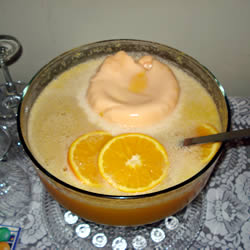The House on Telegraph Hill: Orange Sherbet Champagne Punch Recipe
/Year Released: 1951
Directed by: Robert Wise
Starring: Richard Basehart, Valentina Cortese, William Lundigan
(NR, 93 min.)
Genre: Mystery and Suspense

“You think it's easy to kill somebody? It takes time and patience and a strong stomach.” Alan Spender
Take a trip back to the fifties when films were about people instead of men in tights and Disney cartoon remakes. When plot twists were believable instead of tacked on like the gyrating tail of a dying dragon. Making the mystery, greed, and murder all the more intoxicating.
Is she a calculating gold digger or merely a survivor? Victoria Kowelska (Valentina Cortesa) has tasted the joy and bitterness of life in war torn Poland, her handsome husband and elegant estate ripped from her almost overnight. In the concentration camp that follows, she fights for food for herself and the weak countrywoman, Karin Dernakova (Natasha Lytess) she has befriended.
Karin wants to live to see the young son she has smuggled out of Poland to live with her wealthy aunt in San Francisco, but she dies just before the camp is liberated. On impulse, Victoria seizes the crumpled packet of identity papers from her dead friend and passes herself off as Karin, hoping it will help her get to America, but she receives a telegram saying the aunt has died.
Only after staying 4 years in a displaced person camp does she finally board a ship to America, where she vows to trace Karin’s son, Chrisopher. His guardian, Alan Spender (Richard Basehart) is attracted to “Karin” and proposes marriage.
But this Cinderella story is surface only. Alan’s Prince Charming package seems increasing superficial, especially when “Karin” meets the lovely blond governess Margaret (Fay Baker), who greets her with all the warmth of an ice princess.
All the splendor of the house on the Telegraph Hill seems surface deep, too. The portrait of Aunt Sophie stares down at her, making the false Karin feel a guilty exile in a gilded cage.
Among all the finery, including a 1950s parade of sleek and flamboyant dresses “Karin” wears to dinner, we sense a claustrophobic menace perhaps intensified by the outward glamor and civility. It haunts us like a minor version of Rebecca or Suspicion, each affectionate embrace and “darling” uttered by Alan becoming more and more double edged.
Part of the appeal of The House on Telegraph Hill is that it doesn’t try too hard. We have a slow burning suspense, not the fast action and bizarre plot twists that pander to current audiences. This one takes its time. The only thing close to a car chase is “Karin’s” car spiraling out of control on its downhill trek to market, her brakes of no use. Yes, the old doctored brake trick, somewhat predictable, but effective nonetheless. Today it is all eye candy, each adolescent minded director vying with his peers to push the envelope a little further, until action is about all we get.
The action here is negligible. What we get is its effect on our characters, who slowly lift their painted veils to reveal their true identities and motivations.
It is not little Christopher’s suspicious “chemistry kit” explosion in the tiny outdoor house that we see, only the torn away wall and floor, a gaping hole that almost swallows Karin.
What we have is the slow reveal, not the unsubstantiated shock we have come to expect today. And somehow, that is inherently so much more satisfying in the long run.
Take a break from your hectic routine and travel back to a simpler time when moviegoers were treated like adults instead of middle-aged adolescents. An added bonus: it is in black and white; no crayon colorization has tainted this littel gem.
–Kathy Borich

Trailer
Film-Loving Foodie
Our recipe combines two bits of interesting trivia from our 1951 film, The House on Telegraph Hill.
Richard Basehart, who had lost his wife that year, fell in love with his Italian co-star Valentina Cortese during the filming. They were not just husband and wife on screen, but actually married in real life as well.
Richard made $1750 per week for his role; Valentina, less than half, $800. Certainly not anywhere near what our megastars haul in today, but by those standards, not bad.
I am sure they could afford to serve lots of this very simple and yet elegant champagne punch to their real life wedding guests.
Enjoy.
Orange Sherbet Champagne Punch

1 container of Orange Sherbet
1 two liter bottle of Ginger Ale
1 bottle of Champagne
In punch bowl, empty out one container of Orange Sherbet. Pour in a 2 liter bottle of Ginger Ale and one bottle of Champagne.....A real party favorite.....Mmmmm CHEERS









